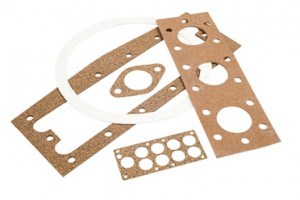Gasket Manufacturer located in the UK
We are a gasket manufacturer based in the UK. Our manufacturing facility is in Cornwall.
We stock our materials, and cut and despatch our gaskets from this location. With over 1200 materials and multiple ways of cutting your gaskets. As such we can provide fast turnaround in critical situations to the whole of the UK. Contact us with your requirements and one of our team will support your inquiry.
Our general production times fit with your schedule and volume requirements. We can provide prototypes and samples, test gaskets for different material types, and more. Our responsive team will always consider all your needs and support you in ensuring the best possible fit for your requirements. Use the contact form or call us to start the conversation.

What is a gasket? This is not the easiest of questions to answer. The reason for this is that people can mean many different things when they talk about a gasket; they can be used to perform many different functions. On a very general level a gasket might be defined as a flexible component that sits in-between two other surfaces. In this article well take a brief look at some of the problems in answering the question What is a gasket? Hopefully, by the end of it, this will give you a better idea of what a gasket is and how they work.
The Problem of Defining a Gasket
Gaskets are commonly made of a flexible material such as rubber, paper, or cork. In fact, there are many different materials that gaskets can be made out of (we stock some 1,200 different grades) so gaskets cannot simply be defined by means of the material that they are made out of. Gasket materials are, however, typically flexible as they are usually compressed between two other surfaces. Having said this, it is also possible to find gaskets made of metal: such as spiral wound or copper head gaskets.
A similar problem arises when we try and define a gasket by its function. Gaskets can be used for many different purposes, such as: sound and noise reduction, anti-vibration, packaging, hygiene, sealing, and as supports/mountings. For these reasons, gaskets are found in many different products, in many different industries. For instance, gaskets can be found inside of: cars, planes, boats, trains, pumps, and electrical equipment (from electronic tills and hi-fi equipment to lighting and industrial electrical transformers). Gaskets find application in industries as diverse as food processing, petrochemical, oil and gas, pharmaceutical, and water.
The properties of a gasket are typically those of the material out of which it is manufactured. For this reason, gasket materials are selected for their characteristics: such as their resistance to chemicals, acids, alkaline, extreme temperatures, and pressures, and their ability to withstand different environments (such as deep-sea, mining, and even in space). Similarly, the specification of a gasket is defined by its operating environment.
Gaskets for Sealing Purposes

Perhaps the most common use of a gasket is as a component of a sealing system, in which one of the major functions of the gasket is to create a seal between two other surfaces. (For instance, pipe gaskets are used to create a seal between two pieces of pipe when laying a pipeline). The exact function of a gasket in this respect is to prevent the escape or ingress of fluids (liquids or gases) even at extreme pressure and temperature. Yet the function of a gasket is not only to provide a seal to prevent liquids or gases from escaping, but it is also an important safety device. In this respect it is important for the gasket to be the weakest component of the sealing system so that it fails in response to a problem.
The consequences of a gasket not failing in response to a problem are far greater than simple gasket failure. If the gasket does not fail in response to a build-in pressure then the consequence is the potential bursting of the pipe and/or explosion.
It is also important that the gasket allows for essential maintenance, by allowing the sealing surfaces to be separated and reassembled. For this reason, it is important for the gasket to remain in good condition for as long as possible. The life of a gasket can be significantly improved by selecting the right material for the application, and by taking into account all of the features of the environment in which it will be used.
Conclusion
As we have seen, its not easy to define what a gasket is: as they can be made out of many different materials, perform many different functions, and be used in many different industries. Having said this, the most common use of a gasket is to interface between two surfaces to improve the function of the components.
If you have any technical questions then please contact us.
What Are the Different Types of Gaskets?
The most common types of gaskets are:
- Gaskets used in piping (flange gaskets)
- Gaskets used in vehicles (cars, boats, planes, trains etc.)
- Gaskets with certain material properties (cork, rubber paper etc.)
- Gaskets used for a particular function (for pressure, temperature or chemical resistance)
- Bespoke or custom made gaskets
Gasket Types and Uses
Gaskets can be classified in many different ways, for example: by material, by function, or by application. A gasket is basically a part cut from a (usually) flexible material, which sits in between two other surfaces. Gaskets are typically manufactured from soft materials (such as rubber); one of the most common uses is for sealing pipes to prevent the leakage of liquids. Gaskets also have certain other common applications, such as anti vibration and mounting.
Gasket Types by Material
Gaskets will inherit the properties of the materials from which they are manufactured. Gasket materials are used because of their resistance to certain chemicals (such as acids) or properties of being capable of withstanding extreme temperatures or pressures.
Common types of gaskets include:
Rubber Gaskets
Rubber is a soft gasket material. A wide range of elastomers can be used, such as neoprene, nitrile, EPDM and natural rubber. Rubber gaskets are used in a wide range of applications such as pipe gaskets, heat exchangers, and manways.
Non-Asbestos Gaskets
Non-asbestos gaskets are manufactured from a compressed fibre with an elastomer binding; and are used in many applications such as acid, steam, oil and water.
Cork Gaskets
Natural cork combined with elastomer bindings giving high flexibility and compression. These gaskets are widely used in applications involving oil, fuel and solvents.
Gasket Uses

Gaskets can also be grouped into different types by their functions, or uses. Some of the most common uses of gaskets are as follows:
Sealing
Liquid Seals
One of the main functions of a gasket is to seal against the leak or ingress of liquids. The rubber in liquid seals should be specified to the liquids used in the process. Certain rubber types offer better resistance to chemicals, such as viton, whereas nitrile is more suited to industries involving oils, fuels and solvents.
Environmental Seals
Environmental seals guard against dust and other environmental contaminants. These seals are used in enclosures, such as electrical enclosures. Enclosures the world over have requirements for access for maintenance. Generally, these enclosures contain control equipment that is essential to the operation of the installation that they are linked to.
A foam rubber door gasket fitted to these enclosures play an important part in keeping the integrity of the enclosure and ensuring the equipment inside is kept in an optimum working environment.
Anti Vibration
Vibration, as with sound, has frequencies. Anti-vibration pads or flooring are a way of disrupting those frequencies and reducing the amount of energy wasted or damage caused by vibration.
Anti-vibration methods are used in area such as machinery mountings, pipe supports or structural bearings.
Mountings
With technology today involving more digital displays to provide information, equipment manufacturers need to protect the sensitive display units from shock, ingress of dust or other particles that may include liquids.
Electrical switchgear also involves the providing of information via displays and typically can require access panels that need gaskets to ensure integrity of protective ratings.
Types of Gaskets in Piping & Flanges

Pipe gaskets (otherwise known as flange gaskets) are made from wide range of materials such as rubber, non-asbestos and graphite. The gaskets can be bought as either Full Faced (with bolt holes) or Inner Bolt Circle (IBC, ring type or raised face). We hold dedicated tooling for all gasket tables such as:
| BS10 Tables | A | D | E | ||
| EN1092-1 | PN6 | PN10 | PN16 | PN25 | PN40 |
| ASME/ANSI B16.5 | Class 150 | Class 300 | Class 600 | Class 900 | Class 2500 |
Full Faced
A Full Face gasket is one that covers the whole of the flange. It will be easily recognised by the fact that the holes for the bolts to pass through are cut into the gasket material.
IBC (Inner Bolt Circle)
Inner Bolt Circle gaskets (IBC) are also known as ring type or raised face. They sit within the circle of the bolts used to secure the joint and are purely a continuous ring of material.
Segmented
Segmented gaskets are used when the flange is an unusual shape, extremely large or expensive. A segmented gasket is formed by two or more gasket parts being arranged with an overlap, tab, or shaped joint arrangement – so that when it is compressed it provides a continuous seal within the flange joint.
Spiral Wound Gaskets
Spiral wound gaskets are made by winding a metal strip, typically stainless steel and a softer filler material such as graphite or PTFE. The materials are wound from opposite sides giving alternating layers of metal and filler, with the filler material acting as the sealant and the metal as the structural strength.
These gaskets offer the use of lower clamping forces, but are a relatively expensive method of sealing.
Gasket Applications
A couple of examples:
Manway Gaskets

Manway gaskets are used for a range of applications such as fuel tanks, boilers and other types of closed vessels.
The gaskets involved are subject to many design requirements such as shape (round, oval, ob-round), closing mechanism (single stud bolt, several sealing bolts and hinged handles), pressure (standard fuel tanks to steam pressure vessels) and heat requirements.
Any combination of the above design criteria means that the selection of a gasket material to suit is an important part of the overall production sequence.
Transformer Gaskets

Electrical transformers are used to either increase a received voltage or decrease it, depending upon the type of transformer and the required voltage supply.
There are several types of transformer from oil filled to water cooled and they are used in all environments and weather conditions.
Transformer gaskets are used to seal the oil and water tanks against leakage, or used as weather seals to increase the IP (ingress protection) rating of the compartments and to ensure that the transformer enclosures remain accessible.
